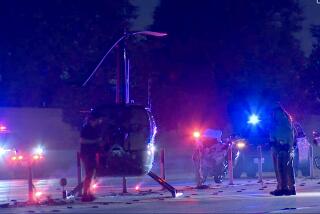Congestion pricing plan may switch routes
As part of a deal-in-the-making over transit funding, Los Angeles Mayor Antonio Villaraigosa is proposing moving the congestion pricing plan for Los Angeles County to the 110 Freeway from the 210 Freeway.
The stretch of the 110 south of downtown has been a candidate for a toll lane since last year, but the 10 and 210 were chosen instead to try to improve east-west travel among L.A., the San Gabriel Valley and the Inland Empire.
Villaraigosa met with legislators from the San Gabriel Valley late last month and proposed the exchange, said Walter Hughes, chief of staff to Assemblyman Ed Hernandez. Hughes said that he thought the move was motivated by two concerns -- the 10 and 210 plan didn’t have the support of the state Legislature, and the mayor was trying to win support for a half-cent sales tax for mass transit funding that he wants to place on the November ballot.
“San Gabriel Valley caucus members had concerns” and so the mayor’s office “figured to alleviate those concerns they would look to move those toll roads to a different stretch of freeway,” Hughes said.
The mayor’s press office on Monday afternoon declined to comment on the 110 proposal. Another source in the Legislature who had direct knowledge of the meeting with the mayor confirmed the exchange. The swap, I’m hearing, was suggested to the mayor by San Gabriel Valley interests -- again, something his office would not comment on.
Bottom line: If congestion pricing happens in Los Angeles County, it will be on the 10 Freeway from downtown to El Monte and the 110 Freeway from just south of downtown to the Artesia transit center at 182nd Street.
There’s a lot of background here. This past spring, the U.S. Department of Transportation awarded Los Angeles County $213 million in new buses, rail cars and other transit improvements. In exchange, the federal agency asked that the county convert carpool lanes on two freeways -- the 10 and 210 -- into variable toll lanes. The toll changes by time of day, the idea being to use high tolls during the busiest times to discourage too many people from using the lanes. That results in faster speeds.
The Bush administration is enamored with the idea, saying that such market-based tolls can clear up congestion and raise money for mass transit. In fact, the idea also has support from across the political spectrum but didn’t go over particularly well here because the 10 and 210 have just one carpool lane in each direction. If carpools with more than three people and buses are allowed into the lane for free -- as is being discussed -- there isn’t that much capacity to sell.
Plus, it didn’t help that the stretches of the 10 and 210 under consideration were both in the San Gabriel Valley. Some public officials there have suggested that most of the burden of the tolls would fall on their constituents.
Holiday freeway fatalities
The numbers are in from the California Highway Patrol: 41 people lost their lives on roads across the state over the holiday weekend, from 6 p.m. Thursday to 11:59 p.m. Sunday night. Twelve of the deaths were in Los Angeles County, including a fiery accident on the Santa Monica Freeway on Sunday morning in which four died when their car hit a bridge pillar and exploded.
CHP spokesman Tom Marshall said 61 motorists died over a comparable period in 2005, the last time the Fourth of July was over a three-day weekend. Marshall said he could only speculate about the cause of the decrease and that perhaps it had to do with the publicity generated about enforcement of the state’s new hands-free cellphone laws, which went into effect last week.
“Maybe people weren’t driving as fast because of the gas prices,” Marshall added.
Arrests made by the CHP for driving under the influence increased this year compared to 2005 -- from 1,600 to 1,684.
--
Steve Hymon writes The Times’ blog about Southern California traffic and transportation in real time. Check it out at latimes.com/bottleneck.
More to Read
Sign up for Essential California
The most important California stories and recommendations in your inbox every morning.
You may occasionally receive promotional content from the Los Angeles Times.










